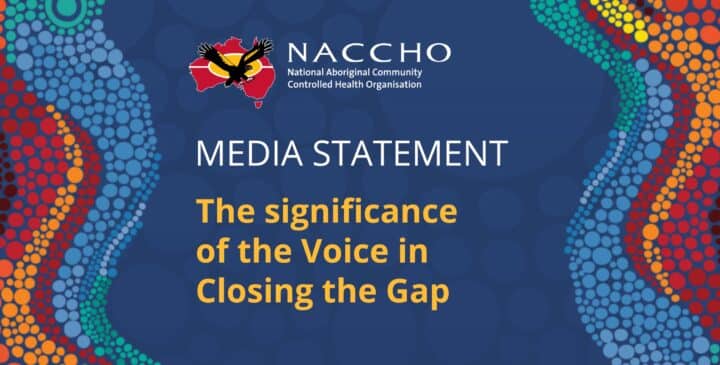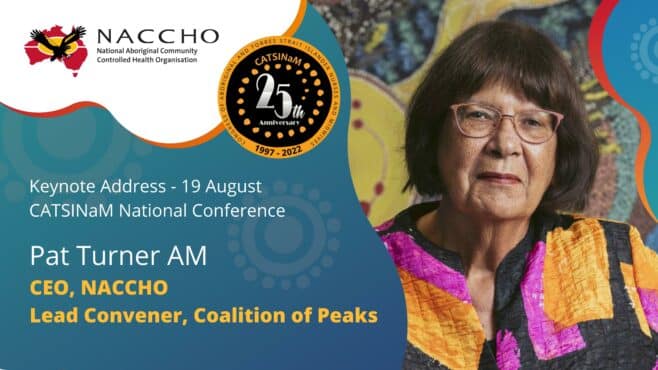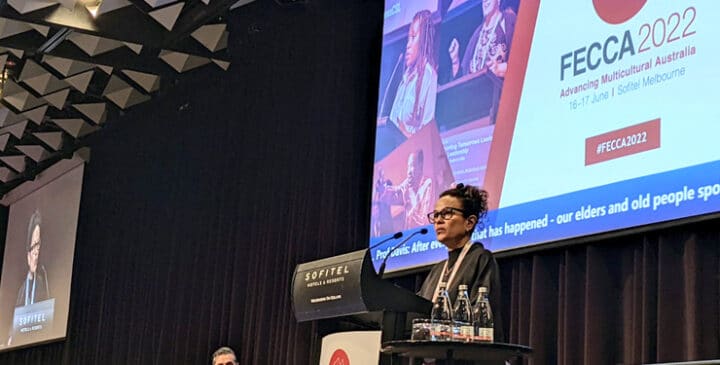

Presentation on the Coalition of Aboriginal and Torres Strait Islander Peak Organisation on Closing the Gap – AMSANT Members
NACCHO CEO Pat Turner
I wish to acknowledge the traditional custodians of the land we are meeting on. I acknowledge and respect our continuing culture and the contribution they make to the life of this vast and important region.
As you know, Aboriginal and Torres
Strait Islander peoples have historically been excluded from decision-making on
the policies and programs that directly affect them and the communities in
which they live. This is despite evidence which demonstrates that the only way
to improve our people’s health and wellbeing is with our full participation in
the design and delivery of services that impact on us. And despite our
collective repeated calls over many years for full participation in decisions
that impact on our lives.
Today I want to share with you how a
group of Aboriginal community controlled organisations, led by NACCHO, have
exercised political agency by leading the way, challenging the possibilities
and imagining a future of shared decision-making with governments on policies
and programs that impact on our people and our communities.
You may remember that in 2007, the
Council of Australian Governments (COAG), comprising leaders of federal, state
and territory, and local governments, committed to ‘closing the gap’ in life
expectancy between Aboriginal and Torres Strait Islander and other Australians.
They also committed to a range of targets to end the disparity between
Aboriginal and Torres Strait Islander peoples and other Australians in areas
like infant mortality, employment and education.
This was the first time that Australian
Governments had come together in a unified way to address the disadvantage
experienced by too many Aboriginal and Torres Strait Islander peoples. The
Commonwealth Government at the time also made an unprecedented investment of
around 4.6 billion dollars in programs and services to ‘close the gap’.
Despite this unprecedented coming
together of Australian Governments and investment, Aboriginal people were not
formally involved in Closing the Gap, it was not agreed by us and it was a
policy of governments and not for our people.
Many Aboriginal and Torres Strait
Islander people felt that Closing the Gap presented the issue of our
disadvantage as a technical problem built around non-Indigenous markers of
poverty. This only served to hide the extent to which Aboriginal and Torres
Strait Islander peoples’ disadvantage is a political problem requiring deep
structural reforms about the way governments work with us.
Closing the Gap did not address the
biggest gap that we face: the gulf between the political autonomy and economic
resources of Aboriginal and Torres Strait Islander peoples and non-Indigenous
people.
The policies and programs that then
followed whilst making some difference to our peoples lives did not achieve
their potential. Now ten years later we have not made the progress against the
closing the gap targets that had been hoped.
In 2017 the Commonwealth Government
embarked on a ‘refresh’ of the Closing the Gap framework and undertook a series
of consultations. The consultations were inadequate and superficial. There was
no independent report prepared on their outcomes. The lack of transparency and
accountability surrounding these consultations were very disappointing, but not
surprising. Many of our organisations, including NACCHO, made submissions to
government on Closing the Gap but we felt like we were ignored.
As the ‘refreshed’ Closing the Gap
strategy was being prepared for sign off by the Australian Governments, our
dismay and disappointment galvanised a small group of community controlled
organisations to come together to write to the Prime Minister, Premiers and
Chief Ministers asking that it not be agreed. NACCHO led the bringing together
of organisations for this purpose. Along with NACCHO, AMSANT and AHCWA were
some of the first organisations to sign up to this letter to the Prime Minister.
We weren’t going away, and there were
three important messages that we wanted governments to hear. These were:
- When Aboriginal
and Torres Strait Islander peoples are included and have a real say in the
design and delivery of services that impact on them, the outcomes are far
better; - Aboriginal and Torres Strait Islander peoples need to
be at the centre of Closing the Gap policy: the gap won’t close without our
full involvement; and - the Council of Australian Governments cannot expect us
to take responsibility and work constructively with them to improve outcomes if
we are excluded from the decision making.
By staying strong and consistent in our
messaging, our voices could not be ignored. In early December, we were invited
to meet with the Prime Minister, who acknowledged that the current targets were
‘government targets’ not ‘shared targets’, and that for Closing the Gap to be
realised Aboriginal and Torres Strait Islander people had to be able to take
formal responsibility for the outcomes through shared decision making.
On 12 December 2018, Australian
Governments publicly committed to developing a genuine, formal partnership
between the Commonwealth, state and territory governments and Indigenous
Australians through their representatives on Closing the Gap and that through
this partnership a new Closing the Gap policy would be agreed.
The initial fourteen organisations then
became almost forty, as we brought together Aboriginal and Torres Strait
Islander Peaks bodies across the country to form a formal Coalition to
negotiate a new Closing the Gap framework with Australian Governments.
We include both national and state and
territory based Aboriginal and Torres Strait Islander Peaks representing a
diverse range of services and matter that are important to us as Aboriginal and
Torres Strait Islander peoples and to Closing the Gap. From our sector –
AMSANT, the TAC, AHCWA are VACCHO actively involved, and QAIHC are also getting
engaged.
As a first step and through our
initiative, we negotiated and agreed a formal Partnership Agreement between the
Council of Australian Governments and the Coalition of Aboriginal and Torres
Strait Islander peak organisations which came into effect in March 2019.
The Partnership Agreement sets out that
the Coalition of Peaks will have shared decision making on developing,
implementing and monitoring and reviewing Closing the Gap for the next ten
years. This is an historic achievement.
It is the first time that Aboriginal and
Torres Strait Islander Peaks have come together in this way, to work
collectively and as full partners with Australian Governments. It’s is also the
first time that there has been formal decision making with Aboriginal and
Torres Strait Islander peoples and Australian Governments in this way.
A key commitment of the Partnership is
the creation of the new Joint Council on Closing the Gap. The inaugural meeting
of COAG’s Joint Council on Closing the Gap took place on 27 March. It is the
first Council established by COAG that has representatives from outside
government, and it marked a historic step forward in the working relationship
between Aboriginal and Torres Strait Islander peoples and governments.
But it is not an easy path that we are
on and there are many challenges.
The Coalition of Peaks are strengthening
their own governance and it is not always easy coming together by
teleconferences to work through our positions as we navigate our distances and
the pace in which we need to work to stay in front of Australian Governments
with their many resources.
We are committed to being transparent
and accountable to each other through consensus-based decision-making. This has
helped us build trust in each other, in our agreed processes of negotiation and
representation, and has made us a strong and effective force to be reckoned
with.
Australian Governments are also slow to
change, and despite agreeing to the formal partnership with us, we are yet to
see them fully embrace what it means to have us at the table and respond to our
propositions.
We have started the task of determining priority
reforms that we think are needed to accelerate the life outcomes of our
peoples, and to be built into a new National Agreement on Closing the Gap for
the next ten years.
We need a radical shift to the way
governments work with Aboriginal and Torres Strait Islander peoples at all
levels of policy design and implementation.
The first priority reform area we have proposed to governments is to ensure the
full involvement of Aboriginal and Torres Strait Islander peoples in shared
decision making at the national, state and local or regional level and
embedding their ownership, responsibility and expertise to close the gap.
This will ensure that, over time, all of
us have a seat at the table and responsibility for making decisions about what
governments do in our areas and communities.
The second priority reform area is placing Aboriginal Community Controlled
Services at the heart of delivering programs and services to our people. When
we are in control and lead services for our peoples the outcomes are so much
better.
If we get agreement to this reform by
governments it will assist our Aboriginal Community Controlled Sector
immensely, as it will help protect our dedicated funding and secure our
position in delivering better health outcomes for our peoples than mainstream
services. As you know, this is a continued contested space for us and something
we continually come up against, including in our negotiations of our funding
agreements and model of care.
Securing support for this reform will
also enable a more transparent conversation on the funding that is currently
going to mainstream service providers for our care, and that we will be able to
work towards having this money progressively transferred into the Aboriginal
Community Controlled Sector.
As you know, we see this too many times
in our space and we need to call it out at the national level and put a stop to
it.
We are also working to get the
governments to make additional funding commitments in vital areas important to
the health of our peoples, in early childhood services and in health homes.
This conversation is hard going with governments but needed if we are to close
the gap.
The Coalition of Peaks have agreed with
Australian Governments that they will lead a series of engagements with
Aboriginal and Torres Strait Islander organisations and communities across Australia
on the priority reform areas during September and October this year.
As part of this work, there will also be
further discussions within the NACCHO affiliates and with members.
I encourage you all to consider what we
have discussed today. We want to hear more about what is needed to give effect
to the priority reforms: how can we make them a success and what do we need
governments to do differently?
What we hear during those engagements
will help the Coalition of Peaks finalise their negotiations with governments
on the New National Agreement by the end of the year.
I look forward to continuing this discussion with you
all.
I wish to acknowledge the traditional custodians of the land we are meeting on. I acknowledge and respect our continuing culture and the contribution they make to the life of this vast and important region.
As you know, Aboriginal and Torres
Strait Islander peoples have historically been excluded from decision-making on
the policies and programs that directly affect them and the communities in
which they live. This is despite evidence which demonstrates that the only way
to improve our people’s health and wellbeing is with our full participation in
the design and delivery of services that impact on us. And despite our
collective repeated calls over many years for full participation in decisions
that impact on our lives.
Today I want to share with you how a
group of Aboriginal community controlled organisations, led by NACCHO, have
exercised political agency by leading the way, challenging the possibilities
and imagining a future of shared decision-making with governments on policies
and programs that impact on our people and our communities.
You may remember that in 2007, the
Council of Australian Governments (COAG), comprising leaders of federal, state
and territory, and local governments, committed to ‘closing the gap’ in life
expectancy between Aboriginal and Torres Strait Islander and other Australians.
They also committed to a range of targets to end the disparity between
Aboriginal and Torres Strait Islander peoples and other Australians in areas
like infant mortality, employment and education.
This was the first time that Australian
Governments had come together in a unified way to address the disadvantage
experienced by too many Aboriginal and Torres Strait Islander peoples. The
Commonwealth Government at the time also made an unprecedented investment of
around 4.6 billion dollars in programs and services to ‘close the gap’.
Despite this unprecedented coming
together of Australian Governments and investment, Aboriginal people were not
formally involved in Closing the Gap, it was not agreed by us and it was a
policy of governments and not for our people.
Many Aboriginal and Torres Strait
Islander people felt that Closing the Gap presented the issue of our
disadvantage as a technical problem built around non-Indigenous markers of
poverty. This only served to hide the extent to which Aboriginal and Torres
Strait Islander peoples’ disadvantage is a political problem requiring deep
structural reforms about the way governments work with us.
Closing the Gap did not address the
biggest gap that we face: the gulf between the political autonomy and economic
resources of Aboriginal and Torres Strait Islander peoples and non-Indigenous
people.
The policies and programs that then
followed whilst making some difference to our peoples lives did not achieve
their potential. Now ten years later we have not made the progress against the
closing the gap targets that had been hoped.
In 2017 the Commonwealth Government
embarked on a ‘refresh’ of the Closing the Gap framework and undertook a series
of consultations. The consultations were inadequate and superficial. There was
no independent report prepared on their outcomes. The lack of transparency and
accountability surrounding these consultations were very disappointing, but not
surprising. Many of our organisations, including NACCHO, made submissions to
government on Closing the Gap but we felt like we were ignored.
As the ‘refreshed’ Closing the Gap
strategy was being prepared for sign off by the Australian Governments, our
dismay and disappointment galvanised a small group of community controlled
organisations to come together to write to the Prime Minister, Premiers and
Chief Ministers asking that it not be agreed. NACCHO led the bringing together
of organisations for this purpose. Along with NACCHO, AMSANT and AHCWA were
some of the first organisations to sign up to this letter to the Prime Minister.
We weren’t going away, and there were
three important messages that we wanted governments to hear. These were:
- When Aboriginal
and Torres Strait Islander peoples are included and have a real say in the
design and delivery of services that impact on them, the outcomes are far
better; - Aboriginal and Torres Strait Islander peoples need to
be at the centre of Closing the Gap policy: the gap won’t close without our
full involvement; and - the Council of Australian Governments cannot expect us
to take responsibility and work constructively with them to improve outcomes if
we are excluded from the decision making.
By staying strong and consistent in our
messaging, our voices could not be ignored. In early December, we were invited
to meet with the Prime Minister, who acknowledged that the current targets were
‘government targets’ not ‘shared targets’, and that for Closing the Gap to be
realised Aboriginal and Torres Strait Islander people had to be able to take
formal responsibility for the outcomes through shared decision making.
On 12 December 2018, Australian
Governments publicly committed to developing a genuine, formal partnership
between the Commonwealth, state and territory governments and Indigenous
Australians through their representatives on Closing the Gap and that through
this partnership a new Closing the Gap policy would be agreed.
The initial fourteen organisations then
became almost forty, as we brought together Aboriginal and Torres Strait
Islander Peaks bodies across the country to form a formal Coalition to
negotiate a new Closing the Gap framework with Australian Governments.
We include both national and state and
territory based Aboriginal and Torres Strait Islander Peaks representing a
diverse range of services and matter that are important to us as Aboriginal and
Torres Strait Islander peoples and to Closing the Gap. From our sector –
AMSANT, the TAC, AHCWA are VACCHO actively involved, and QAIHC are also getting
engaged.
As a first step and through our
initiative, we negotiated and agreed a formal Partnership Agreement between the
Council of Australian Governments and the Coalition of Aboriginal and Torres
Strait Islander peak organisations which came into effect in March 2019.
The Partnership Agreement sets out that
the Coalition of Peaks will have shared decision making on developing,
implementing and monitoring and reviewing Closing the Gap for the next ten
years. This is an historic achievement.
It is the first time that Aboriginal and
Torres Strait Islander Peaks have come together in this way, to work
collectively and as full partners with Australian Governments. It’s is also the
first time that there has been formal decision making with Aboriginal and
Torres Strait Islander peoples and Australian Governments in this way.
A key commitment of the Partnership is
the creation of the new Joint Council on Closing the Gap. The inaugural meeting
of COAG’s Joint Council on Closing the Gap took place on 27 March. It is the
first Council established by COAG that has representatives from outside
government, and it marked a historic step forward in the working relationship
between Aboriginal and Torres Strait Islander peoples and governments.
But it is not an easy path that we are
on and there are many challenges.
The Coalition of Peaks are strengthening
their own governance and it is not always easy coming together by
teleconferences to work through our positions as we navigate our distances and
the pace in which we need to work to stay in front of Australian Governments
with their many resources.
We are committed to being transparent
and accountable to each other through consensus-based decision-making. This has
helped us build trust in each other, in our agreed processes of negotiation and
representation, and has made us a strong and effective force to be reckoned
with.
Australian Governments are also slow to
change, and despite agreeing to the formal partnership with us, we are yet to
see them fully embrace what it means to have us at the table and respond to our
propositions.
We have started the task of determining priority
reforms that we think are needed to accelerate the life outcomes of our
peoples, and to be built into a new National Agreement on Closing the Gap for
the next ten years.
We need a radical shift to the way
governments work with Aboriginal and Torres Strait Islander peoples at all
levels of policy design and implementation.
The first priority reform area we have proposed to governments is to ensure the
full involvement of Aboriginal and Torres Strait Islander peoples in shared
decision making at the national, state and local or regional level and
embedding their ownership, responsibility and expertise to close the gap.
This will ensure that, over time, all of
us have a seat at the table and responsibility for making decisions about what
governments do in our areas and communities.
The second priority reform area is placing Aboriginal Community Controlled
Services at the heart of delivering programs and services to our people. When
we are in control and lead services for our peoples the outcomes are so much
better.
If we get agreement to this reform by
governments it will assist our Aboriginal Community Controlled Sector
immensely, as it will help protect our dedicated funding and secure our
position in delivering better health outcomes for our peoples than mainstream
services. As you know, this is a continued contested space for us and something
we continually come up against, including in our negotiations of our funding
agreements and model of care.
Securing support for this reform will
also enable a more transparent conversation on the funding that is currently
going to mainstream service providers for our care, and that we will be able to
work towards having this money progressively transferred into the Aboriginal
Community Controlled Sector.
As you know, we see this too many times
in our space and we need to call it out at the national level and put a stop to
it.
We are also working to get the
governments to make additional funding commitments in vital areas important to
the health of our peoples, in early childhood services and in health homes.
This conversation is hard going with governments but needed if we are to close
the gap.
The Coalition of Peaks have agreed with
Australian Governments that they will lead a series of engagements with
Aboriginal and Torres Strait Islander organisations and communities across Australia
on the priority reform areas during September and October this year.
As part of this work, there will also be
further discussions within the NACCHO affiliates and with members.
I encourage you all to consider what we
have discussed today. We want to hear more about what is needed to give effect
to the priority reforms: how can we make them a success and what do we need
governments to do differently?
What we hear during those engagements
will help the Coalition of Peaks finalise their negotiations with governments
on the New National Agreement by the end of the year.
I look forward to continuing this discussion with you
all.

